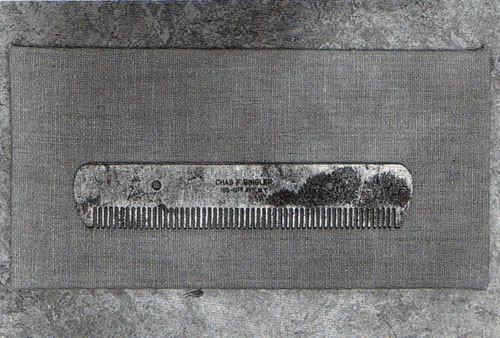
Comb
or
Peigne
|
Original Version:
11 A.M., Feb. 17, 1916, New York |
 |
| Original version, 1916 |
In the Green Box, Duchamp wrote the following detailed plans for creating/choosing Readymades: "planning for a moment to come (on such a day, such a date, such a minute)..." (Sanouillet 32). A steel comb dated to the exact hour of its creation and complete with an enigmatic inscription along its narrow edge, Comb demonstrates the purest following of these instructions. Duchamp himself attests to this time and time again: "During forty-eight years it has kept the characteristics of a true readymade: no beauty, no ugliness, nothing particularly aesthetic about it..." (Schwarz 643).
Co-authored by Arensberg, this Readymade has the following enigmatic inscription printed along its narrow edge in white paint: "3 OU 4 GOUTTES DE HAUTEUR N'ONT RIEN A FAIRE AVEC LA SAUVAGERIE." According to Ades, this translates to "3 or 4 drops from [of] height have nothing to do with savagery," thus lending the piece a sadistic sense (156). This same allusion may also be seen in the hooks ready to trip us up and the anticipated broken arm in other Readymades.
Different interpretations of the mysterious inscription suggest additional meanings, including "3 or 4 tastes of the author have nothing to do with civilization" (Jones 139-40). Moffitt claims the phrase translates to: "3 or 4 drops [of sperm/semen?] [falling] from above have nothing to do with savagery or barbarism" (231). Of course, it is important to keep in mind that the title is only one among the many linguistic experiments with French and English that Duchamp performed with his Readymades.
 |
| Replica, 1963 |
A comb inherently refers to the idea of caressing one's hair, a very sexually loaded act of everyday life; thus this piece illustrates the meeting of two of Ducham's preoccupations: (1) the everyday and (2) the sexual. Ramirez notes the similarity between Comb's sexual reference and that of another one of Duchamp's Readymades. Moffitt points out that a homophone for Comb's title is "péne" or "penis" (231). Reading into it further, he suggests the following comparison: both this Readymade and the male phallus produce sexual "drops" (Moffitt 231).
The task of identifying precisely what type of comb this Readymade is poses a challenge. Most sources describe Comb as a dog comb, but some argue otherwise. Varnedoe identifies Comb as a "partially disassembled cattle comb," noting the two holes and comparing them to magazine illustrations of cattle combs. He suggests that these holes were originally intended for screws or nails attaching it to an "easy grip" wood handle (274). Girst also questions the common dog comb identification, noting another alternative style that would have utilized the two holes (5). Either way, whether Comb was originally intended for dogs or cattle, it has clearly animalistic (and thus sexual) connotations.
Replicas:
1) 1963, Stockholm
Moderna Museet, Stockholm
Gift of the Moderna Museets Vanner
16 x 3 cm
Made by Ulf Linde for Duchamp retrospective, Stockholm, 1963
2) 1964, Milan
Edition of 8 replicas, identical in size, etc. in wooden carrying box
Made under Duchamp's supervision
Inscribed on each replica: "Marcel Duchamp 1964 1/8-8/8"
Small copper plate affixed to box: "Duchamp 1964 1/8-8/8"; engraved underneath: "Peigne 1916 Edition Galerie Schwarz, Milan"
Two replicas made outside the edition for the artist and publisher and two more for the exhibition